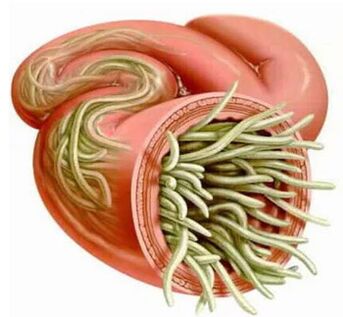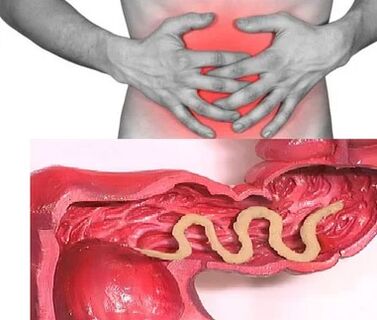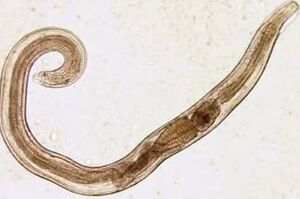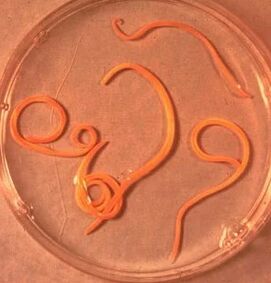To date, science is known for 280 species of worms that can develop and live in the human body by parasitizing in different organs and tissues.The incidence of human infection depends on the climatic and socio-economic conditions of specific territories (in the underdeveloped countries, especially in those located in the tropical and subtropical zone, the level of parasitic infections is much higher than in economically developed conditions).
Human Helminth Infection Methods:
- Biogelminthosis (animal infection).
- Contagioine Helminthoses (transmitted from person to person).
- Geogelminthosis (diseases caused by parasites conducting one of the vital cycles in the earth).

Factors affecting the manifestations of helminthiasis
The method of parasite penetration into the body:
- The degree of adaptation of helminth to the human body;
- The density of the population (quantity) of parasitic individuals;
- The habitat of worms (tissue parasites live in the thickness of the soft tissues, and the cleansing live in the gaps of the hollow organs).Some helminths in different phases have educational and fabrics.The larvae and developing stages of worms as a rule cause more pronounced pathological changes.
In the absence of a re -infection, the number of parasites for adults in the human body does not increase.This characteristic significantly distinguishes the helminth invasions of diseases caused by bacteria, viruses, fungi and simple organisms.
Worms in humans: Symptoms
Helminthosis is a disease characterized by 2 stages of the course (acute, two weeks to two months) and chronic (from several months to several years).
Symptoms of acute phase of helminthiasis
The first signs of the disease may occur at different times (most often after 2-3 weeks, with ascaridosis-after 2-3 days, and with the phylaiosis, the incubation period can last 6-18 months).
In the acute stage of parasitic invasion, the most characteristic symptom is an allergic reaction (antibodies are generated into antigens of migrating larvae of parasites).Often, itching rashes, prone to the recurrent course, have an increase in the recurrent course, regional lymph nodes appear on the skin and the appearance of generalized or local edema, muscle and joint pain may occur.Also, migrating the larvae of the parasite can cause chest pain, coughing, suffocation of suffocation, stool disorders, nausea and vomiting.
At the same time, the acute phase of helminthiasis can be accompanied by more serious disorders (severe forms of pneumonia, hepatitis, allergic myocarditis, hepatosterogalia (enlargement of the liver and spleen).
In the blood, the amount of eosinophils (eosinophilia) increases the normal quantitative ratio between protein fractions (dysproteinemia).

Signs of chronic helminthiasis
The symptoms of the chronic phase are directly dependent on which organ is "populated" with parasites, as well as their size and quantity play an important role.
So when a parasite in the intestine of single individuals, the disease can occur asymptomatic (except in cases of infection with very large parasites).The characteristic characteristics of the chronic phase of the intestinal helminthiasis are dyspeptic disorders.In children, acenoarotic and pain syndrome is more pronounced.With massive ascaris invasion, intestinal obstruction is possible mechanical jaundice and pancreatitis.
By consuming all the substances necessary for their vital activity from the host body, the helminth causes digestive disorders, disorders of the absorption of vitamins, minerals, carbohydrates, proteins and fats.At the same time, the products of the life of worms inhibit normal intestinal microflora and reduce the body's immune forces.
In people suffering from helminth, due to the weakened immunity and increased cell division process (consequences of constant repair of tissue parasites), the risk of malignant tumors increases significantly.
Types of parasitic helminths in the human body
The causative agents of human helminthiasis are 2 types of worms: round (nematodes) and flat (tape and plates).
Roundworms
Worm
The parasites that cause enterobiosis are small (up to 10 mm) thin cavity worms that have gray-white color.The infection occurs in an alimentary manner (by mouth).The reason for this is dirty hands.Parasite eggs can be in the ground, on the wave of infected animals, unwashed vegetables and fruits, etc.At the same time, with enterobiosis, cases of self -lengthening (especially in children) that occur as a result of meetings areas and subsequent egg ingestion are not uncommon.The cutting larva develops within two weeks in the digestive tract.By engaging in an adult individual, the worm parasites in the lower parts of the small and upper parts of the colon.

Ascarid
Askaride is a large spindle-shaped parasite in the form of red-yellow color, reaching an adult state of 40 cm (women) and 15-25 cm (men).Without a suction glass or other fixing devices, Ascaride can independently move to food masses.The eggs laid by the female parasite feature stools.
Akad infection in the case of absorption of ripe eggs together with water or unwashed vegetables and fruits on which there are soil particles.After the eggs penetrate the intestine, ripe larvae come out of them.Then, introducing into the intestinal wall, they reach the heart according to the flow of blood and from there they fall into the lungs.Through the pulmonary alveoli, the ascarid larva through the respiratory tract again penetrates the oral cavity.After repeated swallowing, the parasite reaches the small intestine where it develops in an adult.The worm lives for 12 months, then dies and stands out with stools.In the gut of an owner, one or several hundred individuals can live.
Vlashev
Vlasov, the cause of trichocephalosis, is a white helminth, which parasitizes in the initial part of the colon and reaches a size of 4-5 cm.The parasite is fed by the blood and tissues of the rectal mucosa.
The eggs subjected to submerged, laid by the female on the walls of the intestine, come out with the stool.Their development occurs in the environment (optimal in the soil).Parasite larvae eggs penetrate the body with an alimentary way, through dirty hands, with water or unwashed vegetables and fruits.

Trichinella
The causative agent of the trichinosis is a small round helminth that reaches 2-5 mm in length.The infection occurs with the use of poor fried meat (pork, bears, wild boar).By penetrating the intestine, the larva of the parasites for 3-4 days ripen to the condition of the sexually mature individual.The life expectancy of the worm is 40 days, after which the parasite dies.Driving the intestinal wall, the larvae penetrate into the bloodstream and are carried in all organs of the human body, precipitating in the muscles.In this case, the respiratory and facial muscles, as well as the muscles-to-bangs of the limbs, are most often affected.
In the first days after the invasion, patients complain of abdominal pain.Then, after about 2 weeks, body temperature rises to 39-40 s, itchy rashes appear on the skin, muscle pain develops and the face swells.During this period, in the case of a large -scale infection, there is a significant risk of death.After about a month, a recovery occurs.The parasite is spiral encapsulated and then died within two years.
Ankylostoma and not -boron
These two parasites are similar to each other by biological characteristics as well as in diseases.This is customary to unite them under the common name (ankylostom).The worms reaching 10-15 mm lengths are parasitized in 12-p.Intestines.It should be noted that this is one of the most common, but at the same time rarely identifies parasites.Worm worms penetrate the human body through the skin when in contact with infected soil.In addition, entering the bloodstream, they, just like ascaris, migrate to the lungs, and then through the bronchi, along with the jumping phlegm - to the digestive tract.Anvilostoma parasitizes in the intestine, attaching to the intestinal wall.A parasite, which feeds exclusively with blood, bites the blood vessels that pierce the mucous membranes, injecting an anti -played component there.During the day, an adult can absorb an average of 0.05-0.35 ml of blood.Therefore, the most characteristic symptom of this helminthiasis is iron deficiency anemia, as well as a change in the ratio of protein fractions (dysproteinemia).
Flatworms
Wide band
It is one of the largest helminths, reaching a length of 10-20 meters.The disease caused by this parasite is called dipylobotriosis.The cycle of worm development begins with freshwater fish or crustaceans.The larva enters the human body, which is the final owner of a wide ribbon with caviar or infected fish fillet.Reaching the small intestine, the parasite is attached to its wall and grows to a sexually mature individual for 20-25 days.
Liver bacon
A parasite causing inventory is a flat worm reaching a length of 7-20 mm.It should be noted that more than 50% of cases of liver plate infection (also called a cat's bintomator) fall on the residents of Russia.The larvae of the parasites begin to develop after the eggs fall into fresh water (the snails swallowed).Then they penetrate the body of the fish (carp, crooked carp, platypus, cockroach).Human infection occurs when you eat infected fish meat, which has not suffered sufficient heat treatment.The larva of the liver bomb from the small intestine penetrates the bile ducts and into the gallbladder, fixing there with two suction glasses.
Pork
These parasites almost identical in structure reach a length of 5-6 meters.Tuziarinchosis and tuziasis infection occurs due to the use of cattle or pork infected with Finnish (one of the intermediate forms of helminthiasis).Visible Finnish, represented in the form of whitish bubbles, reaching 0.5 cm sizes are attached to the wall of the small intestine of a person and after 3 months become an adult individual.The tape parasite consisting of more than 2000 segments is steadily increasing.At the same time, the end segments containing eggs come out and independently move along the colon to the anal opening and then crawl from the anal or stand out in the external environment with the stool.The most characteristic symptoms of helminthiasis are a disorder of the digestive tract.
Echinococcus
For this parasite, a person is an intermediate host.The worm parasites in the human body in the form of Finnish.The last owner of Echinococcus is a wolf, dog or cat.The infection is made allying in contact with animals and environmental objects, with a handful of echinococcus eggs.Once they enter the intestine, they develop oncosphere (six larvae) of them.From the intestine they penetrate the bloodstream and carry throughout the body.
Alveokk
This parasite, which is considered a variety of echinococcus, is the cause of one of the most dangerous helminths (alveococcosis), which is similar in severity to cirrhosis and liver cancer.The infection occurs when the oncosphere is penetrated (eggs with ripe larvae) into the intestine.There the embryo comes out of the egg and, introducing into the intestinal walls, penetrates the bloodstream.In addition, with blood flow, the parasite spreads through all tissues and organs of the body (most often localized in the liver).This is where the main stage of the development of the larvae is formed (a multi -bubble balloon, laurelocyst) is formed).Each camera contains an embryonic parasite head that continues to develop gradually.Lavrocypes are very aggressive entities that are constantly growing due to increasing bubbles and have the ability to germinate in the liver, such as cancer metastases.
Helminthiasis diagnostics
The diagnosis of helminth invasions includes the following events:
- A thorough collection of anamnesis that helps to identify the possible causes of infection;
- Laboratory tests of the stool, blood, the content of 12P intestines, rectal and perianal mucus, muscle tissue, pulmonary chicken, bile.During the analysis, eggs, segments or fragments of parasites can be found.At the same time, the increased content of eosinophils in the blood is also a signal for the presence of helminthiasis.
- In the diagnosis of diseases caused by larvae stages or tissue parasites, serological tests (ELISU, RSC, indirect agglutination, immunofluorescent analysis, etc.).
- In order to identify helminths that affect liver tissue, ultrasound, CT and endoscopic examination are prescribed.
Worms in humans: Treatment
In the acute phase of parasitic infection, the patient is prescribed detoxification and desensitization therapy.In severe disease (liver trematodosis, trichinosis), glucocorticoids are used according to medical indications.
As drugs with specific therapy, taking into account the nature of the pathogen, special chemotherapeutic agents are prescribed for antelmintic chemotherapists.
At the same time, it is recommended that the patient takes antihistamines and enterosorbents.The last stage of treatment involves the use of probiotics that normalize the intestinal microflora.
A special sparing diet is also prescribed (the food should be easily digestible and contain a little fat).
During the period of anthelmintic therapy, the patient needs strict adherence to personal hygiene (to avoid re -infection).At the same time, with many helminths, all family members and persons who are infected in constant contact should be treated.





















